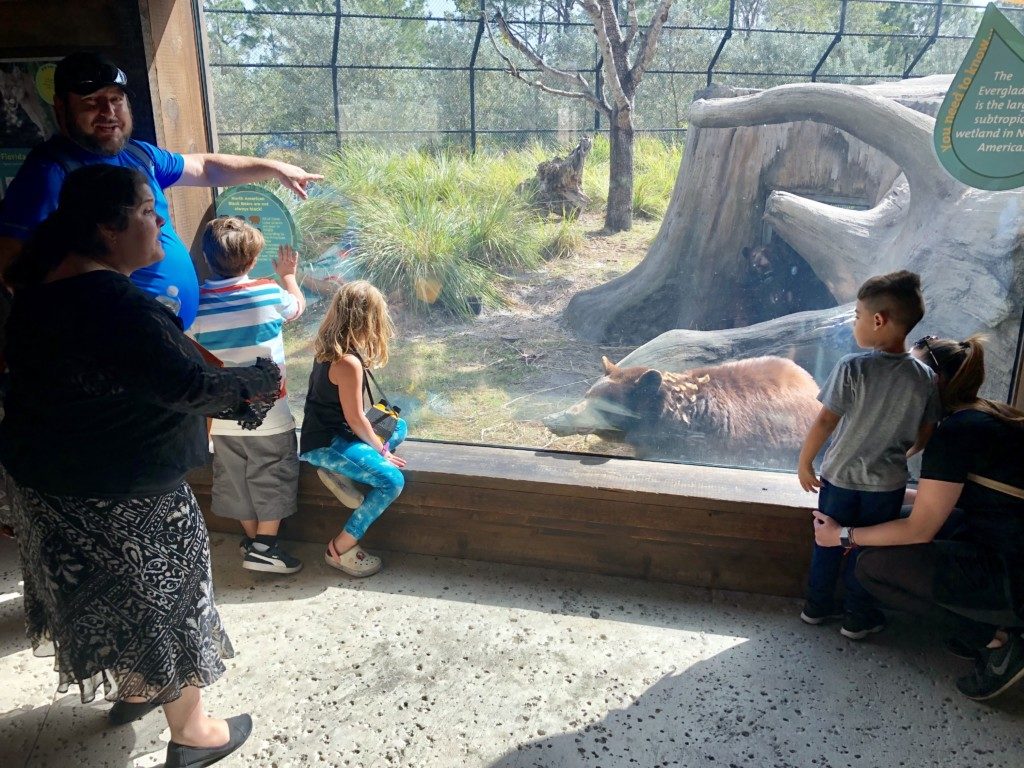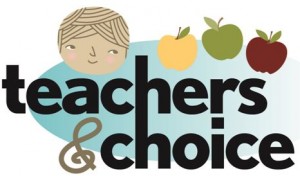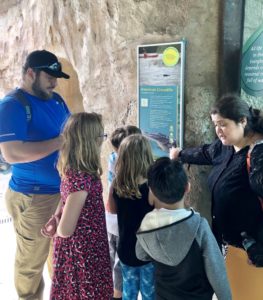
MIAMI – “Guys! Choo-choo formation!” At Ana Garcia’s command, a loose knot of people near the turnstiles at Zoo Miami – three adults, five kids – lined up, put their hands on the back shoulders of the person in front of them, and merged into something less locomotive than caterpillar. Sixteen feet proceeded on a motley ramble. Crocodiles awaited in the Everglades section, along with plenty of carefully guided learning.
So it goes on the education frontier.
Over the next few hours, Garcia, a public-school teacher turned pioneer, subtly steered her students toward goals in their personalized education plans. Project-based learning for one. Ecology for another. Speech therapy for another. She put special focus on the three with autism, including her 9-year-old son, Kevin.
Those students, and two others not in attendance, benefit from a learning option that is revolutionary but under the radar: a state-funded education savings account. It’s ESAs that make Garcia’s home education cluster – and perhaps, someday, a never-ending array of other clusters – possible. Without them, the landscapers, Uber drivers and Dollar Tree clerks who’ve entrusted Garcia with the education of their children would be limited to schools that don’t work for their children.
Garcia knows what that’s like. She endured a nightmare school experience with Kevin before getting an ESA for students with special needs. She says it changed his life – and hers.
“Parents don’t have to fear any more that they only have one choice,” Garcia said.
Neither do teachers.
* * *
 Ana Garcia has a little Mary Poppins about her, no-nonsense but upbeat, with a drive to stoke curiosity that borders on fantastic. Walt Disney is her hero. Some saw swamp; he saw magic kingdom. Garcia feels that about the landscape in education. Her great-grandmother was a teacher in Cuba. Her aunts were teachers. As a kid, her playroom was furnished with a blackboard and old textbooks, and her dolls were her class. Now when she switches into teacher mode, she decelerates her … rapid … fire … speech … until she’s sure her student is catching on.
Ana Garcia has a little Mary Poppins about her, no-nonsense but upbeat, with a drive to stoke curiosity that borders on fantastic. Walt Disney is her hero. Some saw swamp; he saw magic kingdom. Garcia feels that about the landscape in education. Her great-grandmother was a teacher in Cuba. Her aunts were teachers. As a kid, her playroom was furnished with a blackboard and old textbooks, and her dolls were her class. Now when she switches into teacher mode, she decelerates her … rapid … fire … speech … until she’s sure her student is catching on.
“My favorite thing to hear,” she said, “is, ‘Wow miss, no one has ever taught me the way you have, or explained things the way you do.’ “
Garcia loved teaching in district schools. But over the course of a decade, the passion ebbed. Too many mandates. Too much violence. Too little help, in her view, for students with disabilities.
Frustrations began to mount for Garcia the mom, too.
In Pre-K, Kevin was happy and learning in his neighborhood school, in a class with five kids and two teachers. But for kindergarten, he was assigned to an inclusion class with 25 kids, one teacher and one “floating” teacher who toggled between multiple classrooms. Garcia said Kevin’s clothes weren’t being changed when he soiled himself. He wasn’t being fed.
Then Kevin began escaping from class and, somehow, running all the way to a parking lot before being stopped. The first time, Garcia was frightened. The second time, shocked. The third time, angry.
In 2014, after 12 years as a middle school English teacher, curriculum specialist and school-level director for accountability and instruction, Garcia called it quits.
* * *
But this is a story about education in Florida. So that’s not where it ends.

At the zoo, Garcia’s 11-year-old, Gabriella, took photos of black bears and gopher tortoises so she could create a brochure. Her 7-year-old, Khloe, immersed herself in geography. Kevin collected data from exhibit signs, focusing on adaptive traits like bioluminescence.
Garcia knows where each student stands with their learning plans, which she has aligned with Florida education standards. She nudged each towards their targets.
At the Gator Hole, she shifted attention to Angelo, who is 6 and mostly non-verbal. She pointed to a blue crayfish. “What is that Angelo?” she said.
“A crab,” he said.
Not quite, but close enough. And another step for a boy whose gentle face belies a kid once prone to fighting and biting.
Garcia left the district, but she didn’t leave teaching. She just joined the mutiny.
Her cluster isn’t quite sustainable yet, but education savings accounts gives her hope it can be. The main one in Florida (and biggest in the country) is the Gardiner Scholarship. Created by the Florida Legislature in 2014, it now serves 11,276 students with special needs such as autism and Down syndrome, with nearly 1,900 more on a waiting list. (It’s administered by nonprofits like Step Up For Students, which hosts this blog.) Each scholarship is worth about $10,000 a year, and parents can use it for a wide variety of programs and services, including tuition, therapies, tutors, technology, curriculum – whatever a la carte combination they think best.
Angelo’s mom, Vilma Moran, considered several schools. But all wanted to place him in self-contained special education classes where she didn’t think he’d learn. When Angelo started with Miss Ana, he wasn’t talking, didn’t seem to recognize his mom and dad, and showed no emotion.
Now, Angelo loves dinosaurs and laughs at funny videos. Now he greets people by name.
“When we go somewhere, like the zoo, he’ll say, ‘Let’s go see the elephants,’ ” said Moran, who installs fences for a living. “He wasn’t like that two years ago.”
* * *
Kevin is terrified of thunder.
But as Garcia described in The 74, she used the ESA to ease his anxiety – and learn science in the process.
She worked with Kevin’s therapists and tutor to develop lesson plans around the subject of thunder and lightning. The therapists showed him pictures and videos of lightning, taught him calming techniques, and worked with him on articulating why he was scared. The tutor taught him how clouds form and what causes thunder. Knowledge reduced his fear.
“Sometimes, things need to be micro,” Garcia said. In a school district, “you can’t possibly tailor everything to every child. There needs to be a middle ground somewhere. There needs to be a hybrid.”
Or lots of hybrids.
Off the grid, homeschoolers are DIYing into increasingly sophisticated co-ops and enrichment programs. Micro-schools, whether mini-chains or one-offs, are pushing the limits of what’s possible. In Florida, choice scholarships are giving a more diverse mix of parents the opportunity to go small or go home.
Garcia envisions a micro-school that can also serve home education students who want part-time services, combined with a center for Applied Behavioral Analysis. In the meantime, she’s the mutineer at the heart of her cluster, connected to a blooming constellation of other clusters.
For example, a paraprofessional, training to becoming a registered behavioral therapist, joined Garcia and Garcia’s husband on the zoo trip. The five autistic students in Garcia’s orbit all go to the same ABA center, but each is served by different speech, occupational and physical therapists. Kevin has his own tutor, a certified teacher who executes a plan Garcia designed. But the tutor also works with other students in other settings. Once education is de-coupled from school, the potential matches of students and teachers becomes infinite.
Garcia arranged swimming lessons at the Y for some of her students, biscuit-making at Red Lobster for others. Music and martial arts classes are on tap, along with lessons in table manners at Cracker Barrel.
So it goes on the frontier.
* * *
The Miami-Dade school district has 350,456 students, counting 68,487 in charter schools. Throw in private schools, and Miami-Dade has 425,000 students. Competition between sectors may be the most intense in America. And if test scores and grad rates are any indication, students are benefitting.
But none of those schools, so good for so many, were good for Kevin and Angelo. Garcia’s micro-cluster is.
Will it last? Garcia thinks it can work financially with a few more students. But it’s complicated on the edge, and there is no trail. She said she’ll keep pressing to figure it out, and more pioneers every day will do the same.
“If it’s not me,” she said, “it’ll be somebody else.”



I would like to talk with Mrs. Garcia about clusters to start in Central Florida. Do you have her email?
Hi Mrs. C! Just send me an email at rmatus@sufs.org and I will send you the email for Mrs. Garcia.